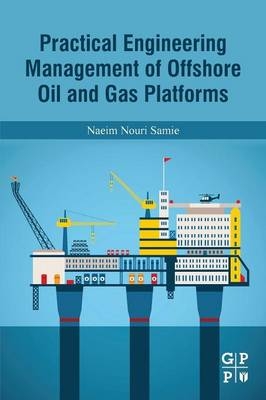
Practical Engineering Management of Offshore Oil and Gas Platforms
Gulf Professional Publishing (Verlag)
978-0-12-809331-3 (ISBN)
Concepts explaining how to interact with the various task forces, getting through bid proposals, and how to maintain project control are all covered in the necessary training reference. Relevant equipment and rule of thumb techniques to calculate critical features on the design of the platform are also covered, including tank capacities and motor power, along with how to consistently change water, oil, and gas production profiles over the course of a project.
The book helps offshore oil and gas operators and engineers gain practical understanding of the multiple disciplines involved in offshore oil and gas projects using experience-based approaches and lessons learned.
Naeim Nouri Samie is currently a Project Engineering Manager with SLT Engineering (based in Malaysia), an engineering firm devoted to oil and gas projects worldwide. His background of over 30 years includes Structural Engineering Discipline Manager, Senior Structural Engineer, and Construction Workshop Engineering Manager. Naeim has worked on multiple oil and gas offshore engineering projects including the current on-going multi-billion project in the South Pars, located in Qatar's giant North Field. Previously, he has worked for Pegasus Oil and Gas Consultants, Iran Marine Industrial Company (SADRA), and Sazehkav Construction Company among others. He has authored many journal and conference publications including two books previously in Persian only, Port Design Guidelines and Offshore Structure Engineering. Samie graduated with a B.Sc. in Civil Engineering from Shiraz University in 1986 and a M.Sc. in Hydraulic Structures from Sharif University of Technology in 1990.
Preface
Part I: Engineering Design of Offshore Platforms
Ch 1: Introduction to Offshore Platforms
1.1 Offshore Platform History
1.2 Oil and Gas Offshore Platforms Types
1.3 Importance of Engineering
1.4 Engineering Practice
Ch 2: Disciplines Involved in Offshore Platform Design
2.1 Architectural
2.2 Control
2.3 Electrical
2.4 HVAC
2.5 Instrument
2.6 Mechanical
2.7 Piping
2.8 Process
2.9 Safety
2.10 Structure
2.11 Telecommunication
Ch 3: Systems and Equipment for Offshore Platform Design
3.1 Process Systems
3.2 Utility Systems
3.3 Instrumentation and Control Systems
3.4 Safety Systems
3.5 Accommodation Systems
Part II: Management, Budgeting, and Scheduling of Offshore Platform Design
Ch 4: Balancing between Client and Task Force Engineers
4.1 Client Requests
4.2 Engineering Team Requirements
4.3 Disciplines/Engineers Mobilization and Requests
Ch 5: Handling Design Documentation
5.1 Master Document Register (MDR)
5.2 Interdisciplinary Checks / Discipline Interfaces
5.3 Document Control Center (DCC)
5.4 Vendor Data Controller (VDC)
5.5 Engineering Disciplines
5.6 General Items to be Checked in Quotation
5.7 Planning Department
Ch 6: Proposal Preparation
6.1 Familiarizing with Proper Requirements
6.2 Approximate Costs
6.3 Proposal Preparation Organization
6.4 Man Hour Weight Distribution
6.5 Unit Costs Calculation
6.6 Miscellaneous Costs
6.7 Changes / Variation Orders
Ch 7: Planning the Project Budget
7.1 Introduction
7.2 Budget Proposal
7.3 Monthly Planning
7.4 Expected Income and Deficits
7.5 Expected Deviations
7.6 Proposals and Incentives
References
Index
| Erscheinungsdatum | 17.05.2016 |
|---|---|
| Sprache | englisch |
| Maße | 152 x 229 mm |
| Gewicht | 860 g |
| Themenwelt | Technik ► Elektrotechnik / Energietechnik |
| ISBN-10 | 0-12-809331-5 / 0128093315 |
| ISBN-13 | 978-0-12-809331-3 / 9780128093313 |
| Zustand | Neuware |
| Haben Sie eine Frage zum Produkt? |
aus dem Bereich


